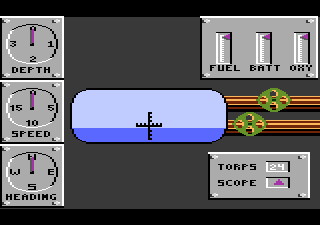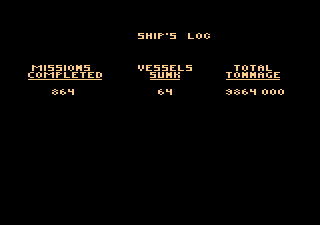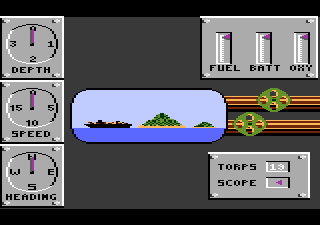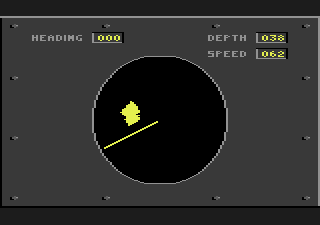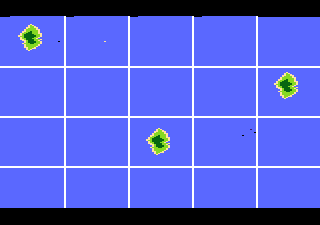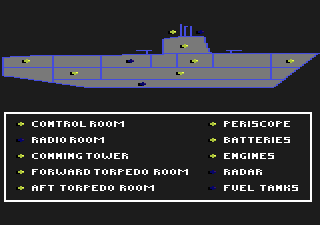|
|
GATO
|
Name:
|
GATO |
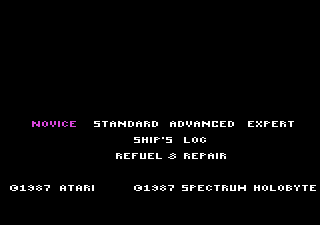 |
| Company: | Atari | |
|
Model #:
|
CX-7827 | |
|
Programmer:
|
Jack Sandberg (ibid inc.) | |
| Year: | 1987 | |
|
Released?
|
No
|
|
|
Notes:
|
Prototype found in 2001 |
War game simulations. A long time staple of PCs their mix of war time strategy and realistic controls make them a must for serious PC gamers. However some time in the late 80's game designers decided to take these complicated games and port them to game consoles. At first this probably sounded like a good idea, add some non-action games to the console libraries and expand your customer base. Unfortunately PC games rarely make for good console games...
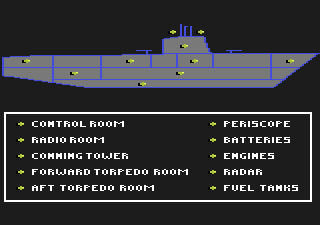
The main problem with GATO, and all console war simulation games, is that the controls are too difficult. Computers have keyboards and mice, consoles (like the 7800) are limited to a joystick and one or two buttons. Sometimes programmers got creative and used buttons on the console itself (pause, select, and reset), but this only added to the complication. However, for what ever reason, the 7800 was blessed (cursed?) with an unusually large number of these games.
In case you haven't guessed by the pictures, GATO is a submarine simulation game (a GATO class submarine to be exact). For many years only one GATO prototype was known to exist, and sadly it very incomplete and not playable. However in 2004 three more WIP versions of GATO were discovered on an old Atari developers hard drive, sparking new interest in the game. Unfortunately it was soon discovered that while these new versions had more features than the earlier prototype, they were still nothing more than a fancy graphics demo.
While the game itself may not be playable, there are several things that can be interacted with:
Title Screen
On the title screen you can select one of four difficulty levels (not that they actually mean anything yet). There are also two extra options 'Ships Log' and 'Fuel & Repair', selecting Ships Log will show a simple game summary screen (Missions Completed, Vessels Sunk, Total Tonnage) with numbers that constantly count up, while the Fuel & Repair option does not appear to be functional.
Periscope Screen
This screen is the most interesting of the four since there are several things you can do. To control your sub select one of three gauges (Depth, Speed, or Heading) by pressing up or down. Once the gauge is highlighted hold down the right fire and press up and down to increase or decrease the gauge value. Increasing the depth will cause your sub to dive, which other than turning the screen blue and using up your oxygen doesn't do much yet. You can also increase your speed, but since you move lightning fast wherever you go in this prototype not matter what the speed setting, this doesn't do much for you either (although you will use up your fuel). Although you can highlight the Heading gauge, you cannot interact with it (although it does change depending on where you move). You can also select Torps or Scope by pressing right on the joystick. Highlighting Torps (torpedoes) and pressing the fire button fires your torpedoes, but doesn't do anything yet in this prototype (other than use up for torpedoes), but selecting Scope will make crosshairs appear in the view. If you have Scope highlighted and hold down the right fire button you can chose the direction you wish to point your periscope.
This screen also has three meters: Fuel, Batt, and Oxy. As you spend time underwater you will see your oxygen slowly deplete, and your fuel will also deplete depending on how fast your speed is set. The Batt (battery) meter never seems to deplete in this prototype. If your Fuel meter reaches zero your speed will slowly drop off and your sub will come to a stop (although you can still move around on the map). Oddly you can still increase your speed after you run out of fuel although it will once again slowly rest back to zero. If you move your ship close to an island or a ship they will appear in the view on this screen. There is a glitch in this prototype that causes ships and islands to appear in the view, even if you're underwater.
Radar Screen
While there isn't anything that can be interacted with on this screen, it is still rather impressive. There is a continual radar sweep that is nicely animated, especially for the 7800. Normally the radar is doesn't display anything, but if you steer your sub close to an island an outline of the island will appear. The Heading, Depth, and Speed displays are all functional, and will display the exact values of the gauges from the periscope screen.
Map Screen
This screen displays a 4x5 map which consists of three islands and a large ocean. There are four blinking dots on this screen, three represent enemy ships, while the other one is your ship. You can move your ship (dot) around by holding down the right button and moving the joystick. If you move near an island or a ship it will appear on the Periscope and radar screens.
Stations Screen
This screen is the most graphically impressive of the lot. This screen displays an overview of your sub, along with all the ships stations. If you are underwater you will notice the Radar and Radio Room buttons will glow blue, this indicates that they are not functional at the moment (it's kinda hard to receive radar images under water). If you run out of fuel you will also see the Fuel Tanks and Engines buttons glow meaning that they are out of commission.
Although the 7800 version never got to a truly playable stage, GATO enjoyed a fair level of success on several other systems (including the Atari XE). It is unknown why Atari decided to stop development on GATO, but it was probably due to the relative unpopularity of the genre on console systems. The last thing the 7800 needed was another overly complicated simulation game. Since the programmer was also assigned to do Hat Trick around this time (a higher priority game), it is unlikely that any further work was done on this title.
| Version | Cart Text | Description |
| 4/24/87 | Version 1.0 | |
| 5/23/87 | GATO 5/23/87 | Early demo |
| 6/11/87 | ||
| 6/23/87 | ||
| 7/27/87 | ||
| 11/??/87 | ||
| 12/??/87 | ||
| 1/??/88 |

